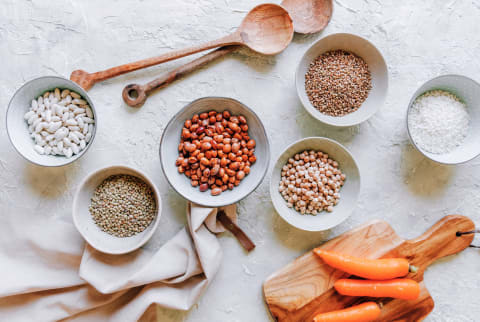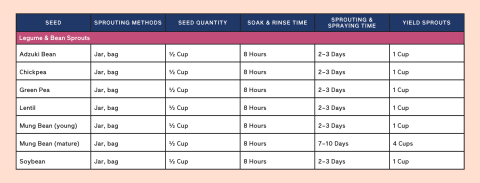Advertisement
An Easy How-To Guide For Sprouting Your Beans & Legumes


Legume and bean sprouts are by far the easiest sprouts to get started with. They can grow in glass jars, trays, and hemp bags. They are the fastest seeds to sprout and reward you with a solid crunch and mild flavor. I love to fill up a bowl with a variety of these sprouts and put them out as a snack instead of nuts or pretzels. At first, people don't know what to think, but once they get started, they really get it, and the sprouts are gone. I even had an old friend from elementary school try to convince me to package up crunchy sprouts and sell them!
Eating legumes may help with many health issues, including reducing cholesterol levels1 and hypertension and complications with diabetes2, fibrocystic breast disease, and prostate cancer3. Because they are so proteinaceous and hearty, they can help moderate blood sugar levels4, not just at the meal but for hours afterward. And when you consume your legumes sprouted, the benefits can increase5 by leaps and bounds!
In addition to using organic seeds and beans whenever possible, I also suggest going a step further and getting seeds and beans that were tested for pathogens and for high germination rates. Lastly, it's important to let them air out and dry for a few hours before putting them into the refrigerator.
Here are a few favorite sprouts to highlight:
Chickpea sprouts
Chickpeas are popular for so many reasons. They taste great, and they are an excellent balance of protein, carbohydrates, and fiber with low amounts of fat. A single serving of chickpeas contains 10 grams of protein (20 percent of the RDI) with only 4 grams of fat, mostly polyunsaturated. The protein-to-fat ratio is perfect for building muscle mass and losing extra weight.
You can add chickpea sprouts to a salad, toss them with chutneys to make the Indian street food chaat, or snack on them out of hand. You can even make hummus with them. If everyone knew how delicious and nutritious sprouted hummus can be, we might start to see a shortage of raw chickpeas!
Lentil sprouts
Lentils are a clear example of the magic of sprouting. They are fast—ready to eat in two to three days—and fairly foolproof. They are hearty, crunchy, and satisfying. They taste neutral to fantastic, which means that you can eat them alone or with many other foods and at any meal. They are divine in lentil mushroom pâté, salads, and even smoothies.
Sprouted lentils have twice the antioxidant content6 as unsprouted. Lentils contain the anti-nutrient phytic acid, but when they are sprouted, the phytic acid gets neutralized and more vitamins and minerals get absorbed. Another fascinating aspect of sprouting lentils is what happens to the vitamin C7. It literally increases over 400% from 5% to 21% of the RDA.
Mung bean sprouts
Sprouting is the preferred use for mung beans. Practically speaking, this makes sense, as 1 gram of seed will yield 9 to 10 grams of mung bean sprouts. Although I always recommend using organic seeds as your first choice, mung bean seeds generally are not treated with fungicides, insecticides, or bactericides because mung bean seeds are predominantly sold for sprouting purposes.
Mung beans are a powerhouse of vitamins and minerals. We all need vitamin C, so you'll be happy to learn that the vitamin C content in mung beans8 goes from 1% to 23% when sprouted. Mung bean sprouts also contain hearty amounts of iron, folate, fiber, and manganese9. A single cup has 43% of the RDI of vitamin K, which regulates bone mineralization and bone density10.
There are two common types of mung bean sprouts: the mature ones that look like a 2-inch white worm and the ones that look like the original mung bean with a little tail. They have similar nutrition and can come from the same seed. The difference is in how long they take to grow and how they taste. The 2-inch sprouts are watery and crisp, and the smaller sprouts are more like a crunchy nut, similar to other legume sprouts. They have a clean, nutty flavor that pairs well with fruits and vegetables. Because they have a high liquid content, you can use them in place of water in blending smoothies, raw soups, and dips.
Wondering how to sprout your legumes and beans? Here's a simple chart to help you get started:

10 Sources
- https://www.ncbi.nlm.nih.gov/pmc/articles/PMC2888631/
- https://jamanetwork.com/journals/jamainternalmedicine/fullarticle/1384247
- https://www.ncbi.nlm.nih.gov/pmc/articles/PMC5546517/
- https://www.ncbi.nlm.nih.gov/pmc/articles/PMC3205742/
- https://www.ncbi.nlm.nih.gov/pubmed/24915317
- https://www.ncbi.nlm.nih.gov/pubmed/28068031
- https://fdc.nal.usda.gov/fdc-app.html#/food-details/168427/nutrients
- https://www.ncbi.nlm.nih.gov/pubmed/23088738
- https://fdc.nal.usda.gov/fdc-app.html#/food-details/342595/nutrients
- https://www.ncbi.nlm.nih.gov/pubmed/11684396
Watch Next
Enjoy some of our favorite clips from classes
Enjoy some of our favorite clips from classes
What Is Meditation?
Mindfulness/Spirituality | Light Watkins
Box Breathing
Mindfulness/Spirituality | Gwen Dittmar
What Breathwork Can Address
Mindfulness/Spirituality | Gwen Dittmar
The 8 Limbs of Yoga - What is Asana?
Yoga | Caley Alyssa
Two Standing Postures to Open Up Tight Hips
Yoga | Caley Alyssa
How Plants Can Optimize Athletic Performance
Nutrition | Rich Roll
What to Eat Before a Workout
Nutrition | Rich Roll
How Ayurveda Helps Us Navigate Modern Life
Nutrition | Sahara Rose
Messages About Love & Relationships
Love & Relationships | Esther Perel
Love Languages
Love & Relationships | Esther Perel
What Is Meditation?
Box Breathing
What Breathwork Can Address
The 8 Limbs of Yoga - What is Asana?
Two Standing Postures to Open Up Tight Hips
How Plants Can Optimize Athletic Performance
What to Eat Before a Workout
How Ayurveda Helps Us Navigate Modern Life
Messages About Love & Relationships
Love Languages
Advertisement

These Peanut Butter Cup Protein Bites Make The Perfect On-The-Go Snack
Molly Knudsen, M.S., RDN










